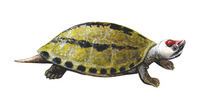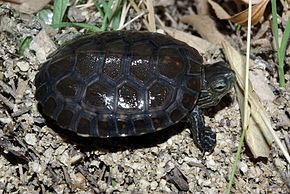Order Testudines Higher classification Testudinoidea | Phylum Chordata Scientific name Geoemydidae Rank Family | |
 | ||
Lower classifications | ||
Not to be confused with Geomyidae.
Contents
The Geoemydidae (formerly known as Bataguridae) are one of the largest and most diverse families in the order Testudines (turtles), with about 70 species. The family includes the Eurasian pond and river turtles and Neotropical wood turtles.
Characteristics

Geoemydidae are turtles of various sizes (from about 10 to 80 cm in length) with often a high degree of sexual dimorphism. They usually have webbed toes, and their pelvic girdles articulate with their plastrons flexibly. Their necks are drawn back vertically. Their carapaces have 24 marginal scutes. The plastron is composed of 12 scutes and has no mesoplastron; the pectoral and abdominal scutes contact the marginal scutes.

Some other features include a single articulation between the fifth and sixth cervical vertebrae, the lack of a hyomandibular branch of the facial nerve, and an epipterygoid bone in the skull.
Ecology
Geoemydidae live in tropics and subtropics of Asia, Europe and North Africa, the only genus in Central and South America is Rhinoclemmys. Their habitats include freshwater ecosystems, coastal marine areas, and tropical forests. Most are herbivorous, but some are omnivorous or carnivorous species. In mating, the males are usually much more active than females. A relatively small number of eggs per clutch is common, produced several times a year. Some species have a temperature-dependent sex determination system, while others possess different sex chromosomes.
About 70% of the extant species have been reported to be in endangered or vulnerable condition.
Systematics and evolution
Traditional systematics placed the geoemydids in the family Emydidae as the subfamily Batagurinae. In the 1980s, the subfamily was elevated to the family status and renamed to Geoemydidae according to the ICZN rules.
Most fossil and molecular data support their close relationship to the family Testudinidae.
The intrafamilial taxonomy is not well established yet, due to the large number and diversity of species. The family is usually divided into two subfamilies and 19 genera. Several species are known to give viable hybrids, which makes the systematics even more complicated.
Subfamilies and genera
The following genera are classified under Geoemydidae.
Conservation
As of the early 2013, six species of the family Geoemydidae are on the CITES Appendix I, and 30 more are on the treaty's Appendix II. A joint China-US proposal for a March 2013 CITES participants' conference seeks to add 15 more Geoemydidae species to the convention's Appendix II.
